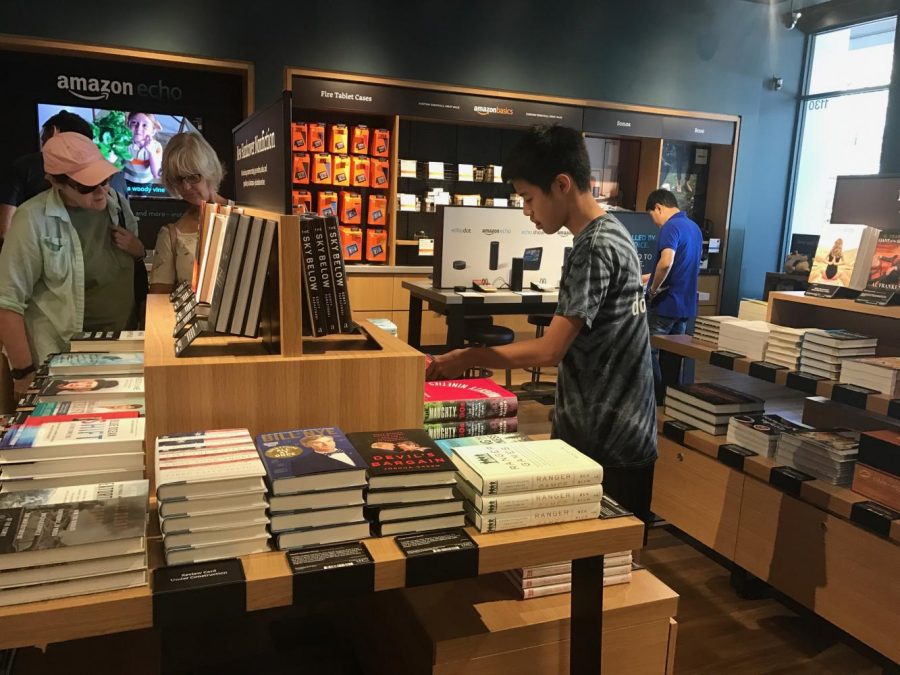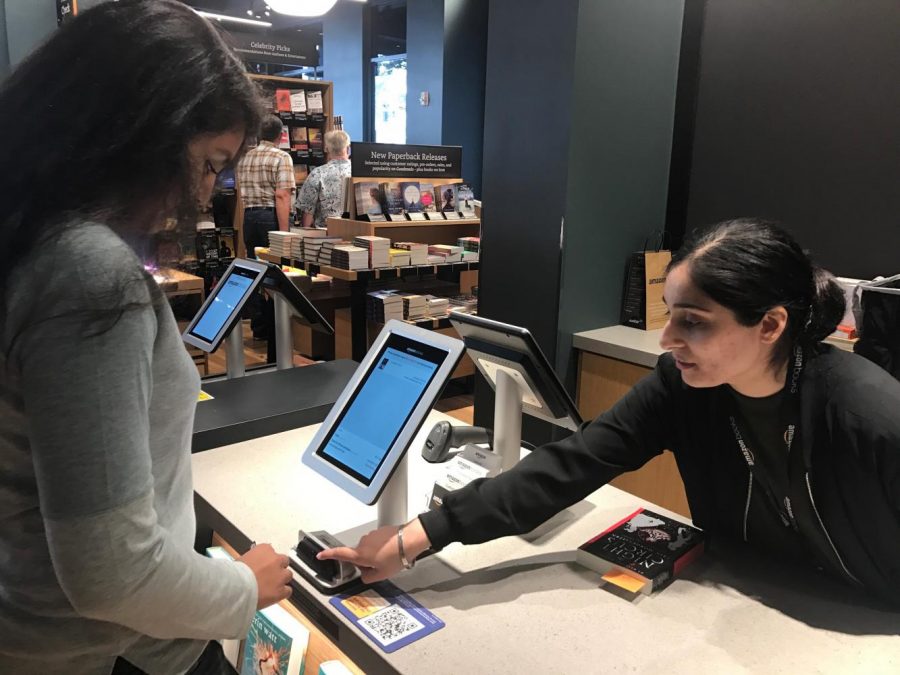From Clicks to Bricks: Amazon expands customer experience by opening bookstores
Evan Chang (10) browses through books at the bookstore. The bookstore at Santana Row opened in August.
October 12, 2017
Before Amazon, inc., was the largest internet retailer in the world, it was an online bookstore. In 1995, CEO Jeff Bezos made the company’s very first sale–a book entitled “Fluid Concepts and Creative Analogies”– out of his own garage, and in the following years, Amazon diversified to provide shoppers with records, CDs, school supplies and tech products.
Today, its marketplace encompasses everything from lemons to lip balm. The company has never stopped selling books, but over the past decade, it has pushed the innovation envelope by introducing a variety of consumer-oriented services such as Amazon prime. Now, Amazon is branching out further, entering the world of offline retail through its opening of brick-and-mortar bookstores and its purchase of Whole Foods Market.
In addition to its merger with Whole Foods, the tech giant has also opened up bookstores across the nation. The merchandise available at Amazon Books is selected based off of consumer satisfaction standards like online reviews and GoodReads ratings.
Over the past month, the bookstore has attracted the interest of many Santana Row visitors.
“I walk past it once a week and I’m really excited because there are no really good bookstores in Santana Row, and I’m especially curious about the Amazon Bookstore–I didn’t know Amazon had a book thing going for it,” sophomore Ashna Reddy said. “I think Amazon expanding into brick-and-mortar is really cool because Amazon is taking over the world.”
Brick-and-mortar refers to companies that operate traditionally rather than electronically and engage in more face-to-face interactions with consumers. Amazon’s physical expansion is a break from the tech company’s history of e-commerce innovations.
“When it comes down to it, the bottom line is their ability to earn,” upper school director of learning, innovation, and design Diane Main said. “Some brick-and-mortar businesses have suffered because they don’t have an online presence; a primarily online business moving into brick-and-mortar potentially saves those brick-and-mortar places but at the same time also diversifies them into the online space.”
In addition to its establishment of Amazon Books, Amazon consolidated its merger with Whole Foods in August. The acquisition came with several immediate changes, including minor reductions in grocery prices as well as special discounts for Amazon Prime members. According to a statement released by Amazon on Aug. 24, Amazon plans to “make healthy and organic food affordable for everyone.”
“There have definitely been price drops across a number of things and that has brought in more customers–we’ve definitely been busier ever since the Amazon acquisition, and going off of that, we have been hiring more,” San Jose Whole Foods Market customer service supervisor Tyler Boyer said. “[Amazon] seems to have a lot more resources to be able to offer things that are lower price, so the partnership seems like a win-win for both of the companies involved.”
While Amazon may be spearheading the resurgence of conventional retail in the E-commerce industry, the combination of technology and brick-and-mortar is far from unprecedented. Over the past few years, several companies–particularly clothing manufacturers such as Bloomingdales and Uniq-Lo and department stores like Macy’s– have benefitted from in-store innovations–from interactive displays to hardware sensors–that optimize both customer experiences and internal operations.
According to AP computer science teacher Anu Datar, Amazon’s corporate reputation may bring other tech companies to follow in suit and diversify beyond a virtual presence in the years to come.
“Any time a big giant does something, everyone wants to follow,” computer science teacher Anu Datar said. “It’s very expensive, and the return on investment is far lesser, so I don’t see all software companies jumping onto the wagon–but there will be more players who will want to give their users a walk-in [experience].”
This piece was originally published in the pages of the Winged Post on October 12, 2017.


















![“[Building nerf blasters] became this outlet of creativity for me that hasn't been matched by anything else. The process [of] making a build complete to your desire is such a painstakingly difficult process, but I've had to learn from [the skills needed from] soldering to proper painting. There's so many different options for everything, if you think about it, it exists. The best part is [that] if it doesn't exist, you can build it yourself," Ishaan Parate said.](https://harkeraquila.com/wp-content/uploads/2022/08/DSC_8149-900x604.jpg)




![“When I came into high school, I was ready to be a follower. But DECA was a game changer for me. It helped me overcome my fear of public speaking, and it's played such a major role in who I've become today. To be able to successfully lead a chapter of 150 students, an officer team and be one of the upperclassmen I once really admired is something I'm [really] proud of,” Anvitha Tummala ('21) said.](https://harkeraquila.com/wp-content/uploads/2021/07/Screen-Shot-2021-07-25-at-9.50.05-AM-900x594.png)







![“I think getting up in the morning and having a sense of purpose [is exciting]. I think without a certain amount of drive, life is kind of obsolete and mundane, and I think having that every single day is what makes each day unique and kind of makes life exciting,” Neymika Jain (12) said.](https://harkeraquila.com/wp-content/uploads/2017/06/Screen-Shot-2017-06-03-at-4.54.16-PM.png)








![“My slogan is ‘slow feet, don’t eat, and I’m hungry.’ You need to run fast to get where you are–you aren't going to get those championships if you aren't fast,” Angel Cervantes (12) said. “I want to do well in school on my tests and in track and win championships for my team. I live by that, [and] I can do that anywhere: in the classroom or on the field.”](https://harkeraquila.com/wp-content/uploads/2018/06/DSC5146-900x601.jpg)
![“[Volleyball has] taught me how to fall correctly, and another thing it taught is that you don’t have to be the best at something to be good at it. If you just hit the ball in a smart way, then it still scores points and you’re good at it. You could be a background player and still make a much bigger impact on the team than you would think,” Anya Gert (’20) said.](https://harkeraquila.com/wp-content/uploads/2020/06/AnnaGert_JinTuan_HoHPhotoEdited-600x900.jpeg)

![“I'm not nearly there yet, but [my confidence has] definitely been getting better since I was pretty shy and timid coming into Harker my freshman year. I know that there's a lot of people that are really confident in what they do, and I really admire them. Everyone's so driven and that has really pushed me to kind of try to find my own place in high school and be more confident,” Alyssa Huang (’20) said.](https://harkeraquila.com/wp-content/uploads/2020/06/AlyssaHuang_EmilyChen_HoHPhoto-900x749.jpeg)








